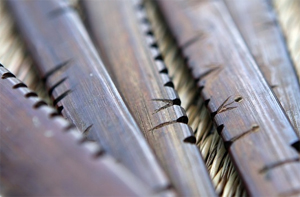
(HBO) – In July 2022, Hoa Binh province’s bamboo calendar of "khaw Doi” (khao Roi, Roi constellation) was recognised as part of the national intangible cultural heritage. This creates a great joy for not only the Muong ethnic group but also the Vietnamese people since the calendar is a long-standing demonstration of folk knowledge that has been upheld and applied to daily activities by Muong people throughout history.
Each Muong area in Hoa Binh has a different name for this bamboo calendar such as "khech Doi” (Doi book, Doi calendar) in Tan Lac, Cao Phong and Lac Son districts, or "fac ben” (notch carving) in some other places.
Culture researcher Bui Noi said for more than 1,000 years, the calendar has been shown on 12 bamboo bars that are about 25cm to over 30cm in length. The bars are inscribed with 30 notches representing 30 days in a lunar month. The notches are signs or symbols demonstrating the weather factors or astronomic phenomena believed to affect those days.
"Ngai khaw Roi” (khaw Đoi) in the Muong language means the Roi/Doi day, or the day of the Roi constellation. Locals in the Muong Bi area of Tan Lac district use the word "Doi” instead of "Roi”. The Roi constellation is the Tua Rua constellation.
Tua Rua is a folk name in the Vietnamese language for the M45 (Pleiades) star cluster in the Taurus constellation. In Vietnam, it is often seen in the early morning in the beginning of June, and can be seen above the eastern horizon in the ninth and 10th lunar months.
Millennia ago, pre-history humans of the Hoa Binh Civilisation (over 20,000 - 7,000 years ago) observed the sky, the movement of the sun, the moon, and stars, weather conditions, as well as wind and sunlight directions to serve their daily life activities.
In the following periods – Phung Nguyen and Dong Son civilisations, humans found the movement paths and rules of the sun, the moon, and stars in each season, on the basis of which they decided months and years. In particular, they realised that when the "khaw Roi (Doi)” constellation appears in the east, from which the sun rises, it’s the time for sow rice seeds.
Vietnam people have a tradition of cultivating wet rice, so worshipping the sun and observing the Roi/Doi/Tua Rua constellation to determine the right time for rice cultivation are of critically importance.
Given this, Muong people named their bamboo calendar after this star
The Government Office with Document No. 2082/VPCP-KGVX, dated March 29, 2024, sent out the opinion of Deputy Prime Minister Tran Hong Ha regarding the submission of the "Mo Muong" and "Cheo art" dossiers to the United Nations Educational, Scientific and Cultural Organization (UNESCO).
In the evening of March 28th, in Hoa Binh, the Department of Grassroots Culture (Ministry of Culture, Sports and Tourism) coordinated with the provincial Departments of Culture, Sports and Tourism and the city to organize a mobile propaganda contest to celebrate the 70th anniversary of Dien Bien Phu Victory (May 7th, 1954 - May 7th, 2024) with the theme "Returning to Dien Bien”. There ứa the attendance of Mr. Nguyen Van Toan, the Vice Chairman of the Provincial People's Committee; the representatives of the leaders from a number of departments, branches and numerous veterans and Hoa Binh people.
In responding to the movement of "All people stay united to build cultural lifestyle”, over the years, Kim Boi district has conducted many practical and effective activities to promote solidarity and mutual support among the local community in sustainable poverty reduction and building cultural lifestyle and a healthy cultural environment, and maintaining national cultural identity.
Hoa Binh Pedagogical College has just held the closing ceremony of the training class and issued the certificate of the language of Muong ethnic people to the oficials, civil servants and public employees of courses I and II in 2023.
Hoa Binh is an ancient land home to limestone mountains running along the southeast direction and in parallel with Truong Son Mountain Range in the West, forming many basins and valleys with a rich diversity of fauna and flora. Humans came to reside here in the pre-historic period, creating the world-famous Hoa Binh Civilisation.


